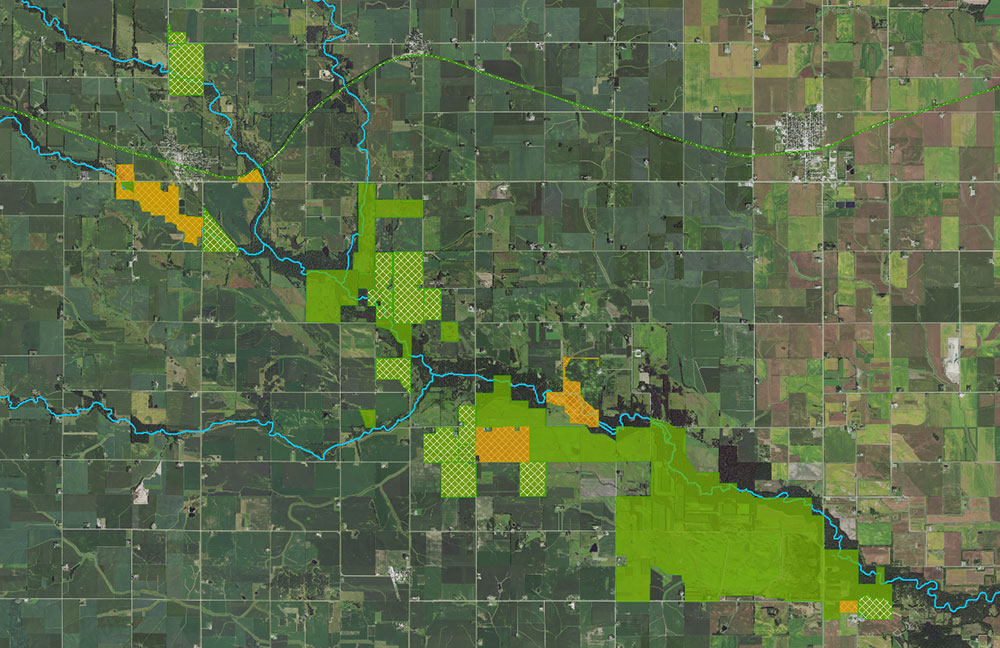A win for wildlife and landowners
By Joe Jayjack on September 19, 2016 in Blog

Wetlands are vital to water quality and home to wildlife, including most of Iowa’s threatened and endangered species. Prior to European settlement, wetlands covered 4 to 6 million acres, or about 11 percent of Iowa’s surface area. In the last 150 years, nearly 95 percent of those wetlands have been drained for agriculture or development.
Today, one of the largest wetland complexes in the state is Big Marsh Wildlife Management Area in Butler County, managed by the Iowa DNR. Spreading out along the floodplain of the West Fork Cedar River downstream from Dumont, Big Marsh encompasses more than 6,000 acres. Adjacent public land makes the complex more than 7,000 acres of protected habitat. But it wasn’t always that way. Most of Big Marsh is made up of restored grassland and wetlands — former agricultural land that has been returned to its more natural state.
Restoration in the area is focused around the Iowa-Cedar Headwaters Wetland Initiative, a partnership project of the Iowa DNR, the USDA’s Natural Resource Conservation Service (NRCS) and the U.S. Fish and Wildlife Service (USFWS) that aims to protect and restore wetlands near the headwaters of the Iowa and Cedar rivers. In 2012, USFWS provided a $3.8 million grant that allowed landowners in the area to enroll in the Wetland Reserve Program, a voluntary program that allows landowners to protect or restore wetlands on their property that are often in marginal agricultural areas.
“It was such a popular program with the landowners, that within about six to eight weeks, that $3.8 million was gone,” said Jason Auel, the DNR Wildlife Biologist in the region.
“Landowners were sick and tired of fighting the river and getting flooded out. It used to be that seven out of 10 years they could get a crop. Then starting in the ’90s when it got wetter, they were lucky to get a crop two to three times out of 10 years.”
 Iowa Natural Heritage Foundation has played an important role in purchasing land from willing landowners that were enrolled in WRP, which is now called Wetlands Reserve Easement. Those landowners often used the money to buy more productive agricultural land elsewhere. INHF would then hold the property until the Iowa DNR could purchase it.
Iowa Natural Heritage Foundation has played an important role in purchasing land from willing landowners that were enrolled in WRP, which is now called Wetlands Reserve Easement. Those landowners often used the money to buy more productive agricultural land elsewhere. INHF would then hold the property until the Iowa DNR could purchase it.
INHF has worked on 15 projects in the complex in the last five years, helping to expand the protected land in and around Big Marsh by more than 2,300 acres. In 2015 alone, INHF purchased five sites totaling more than 500 acres that will eventually transfer to the Iowa DNR.
“There are only a handful of places in the state that have more than 7,000 acres of public wildlife habitat,” said Ross Baxter, land projects director at INHF.
Big Marsh is a major stopover for migrating waterfowl, and has a healthy population of deer and pheasant, making it a popular spot for hunters. The complex also includes three waterfowl refuge areas totaling about 350 acres, and is home to river otters and Blanding’s turtles, a state threatened species.
“All this additional ground has created more area for recreation and more habitat for wildlife,” Auel said. “It’s exciting to see a rebound in some of our animal populations.”